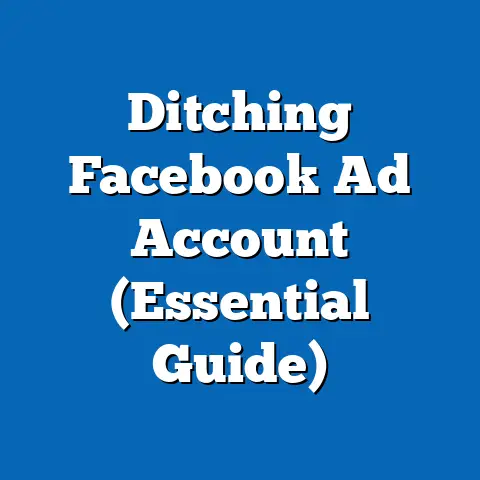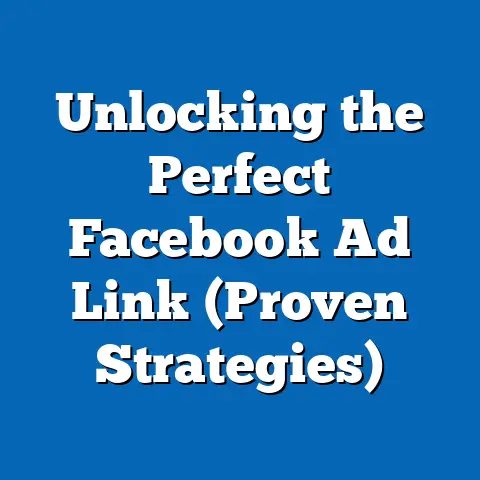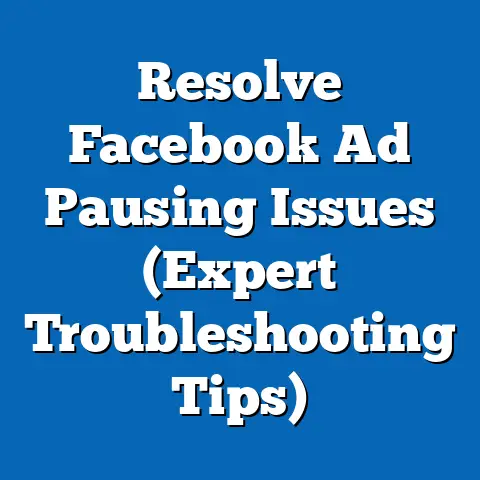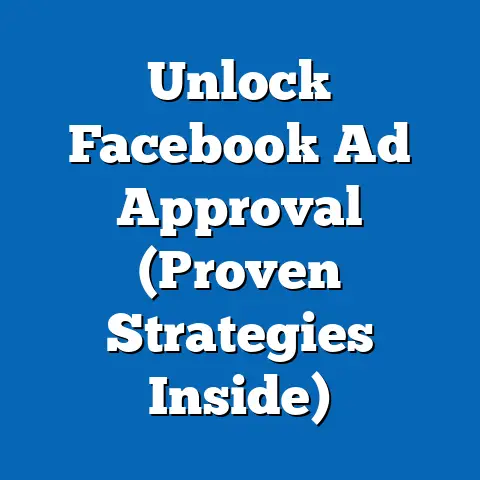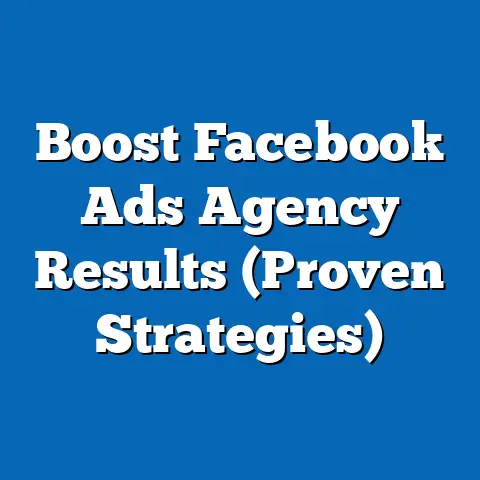Revive Facebook Ads After a Disabled Account (Pro Tips)
What would you do if your primary marketing channel suddenly disappeared overnight?
Imagine this: you wake up one morning, coffee in hand, ready to check your Facebook Ads Manager, only to find a jarring notification – your account has been disabled. The pit in your stomach deepens as you realize that this isn’t just a minor inconvenience; it’s a potential disaster for your business. For many of us, Facebook Ads are the lifeblood of our online marketing strategy, driving traffic, generating leads, and boosting sales. A sudden shutdown can feel like having the rug pulled out from under your feet.
I’ve been there. I remember the sheer panic I felt when one of my client’s accounts was unexpectedly disabled. It was a high-spending account, generating significant revenue, and the immediate impact was devastating. We scrambled to figure out what had happened, why, and most importantly, how to get it back online. It was a stressful experience, but it taught me invaluable lessons about navigating the often-opaque world of Facebook’s advertising policies and account management.
Today, Facebook Ads remain a powerhouse in the digital marketing landscape. According to Statista, Facebook’s advertising revenue reached nearly $116 billion in 2022. This staggering number underscores the platform’s importance for businesses of all sizes. But with great power comes great responsibility – and in Facebook’s case, a stringent set of advertising policies that can be difficult to navigate.
While account disabling can be a daunting setback, it’s not necessarily the end of the road. With the right approach, you can often revive your ad campaigns, regain access to your account, and get back to driving results. This guide is designed to walk you through the process, providing actionable steps, practical tips, and pro insights based on my own experiences and observations in the field. We’ll cover everything from understanding the reasons behind account disabling to crafting a compelling appeal and rebuilding trust with Facebook. Consider this your comprehensive playbook for navigating this challenging situation and coming out stronger on the other side. Let’s get started.
Understanding the Reasons Behind Account Disabling
One of the most frustrating aspects of having your Facebook Ads account disabled is the often-vague explanation provided by Facebook. It can feel like you’re being penalized without knowing exactly what you did wrong. Understanding the common reasons behind account disabling is the first step towards preventing future issues and crafting a successful appeal.
Facebook’s primary concern is user experience. They want to ensure that users are not bombarded with misleading, offensive, or irrelevant ads. Therefore, their advertising policies are designed to protect users and maintain the integrity of the platform. Violations of these policies, whether intentional or unintentional, can lead to account disabling.
Here are some of the most frequent reasons why Facebook might disable an ad account:
- Policy Violations: This is the most common reason. Facebook’s advertising policies are extensive and cover a wide range of topics, including:
- Prohibited Content: Ads promoting illegal products or services, discrimination, hate speech, violence, or misinformation are strictly prohibited.
- Restricted Content: Certain types of content, such as ads for alcohol, gambling, or dating services, are subject to specific restrictions and require prior authorization.
- Misleading or Deceptive Claims: Ads that make false or misleading claims about products, services, or business practices are not allowed.
- Personal Attributes: Ads that directly or indirectly reference a person’s race, ethnicity, religion, age, sexual orientation, gender identity, disability, or medical condition are prohibited.
- Low-Quality or Disruptive Content: Ads that are spammy, irrelevant, or disrupt the user experience are likely to be disapproved.
- Suspicious Activity: Facebook’s algorithms are constantly monitoring ad accounts for suspicious activity, such as sudden spikes in ad spend, unusual targeting patterns, or multiple failed payment attempts. This is often triggered by account hacking or unauthorized access.
- Repeated Ad Disapprovals: If you consistently submit ads that violate Facebook’s policies, your account may be flagged and eventually disabled. Even if each individual violation seems minor, the cumulative effect can lead to serious consequences.
- Payment Issues: Problems with your payment method, such as expired credit cards, insufficient funds, or billing discrepancies, can also result in account disabling.
- Violating Community Standards: Even if your ads themselves comply with advertising policies, your overall activity on Facebook, including your personal profile or business page, can impact your ad account’s standing. Violating Facebook’s Community Standards can lead to account suspension or disabling, which in turn can affect your ability to advertise.
- Circumventing Systems: Actively attempting to bypass Facebook’s ad review process or using cloaking techniques to hide the true destination of your ads is a serious violation that can lead to immediate account disabling.
- Inauthentic Behavior: Using fake accounts or engaging in coordinated inauthentic behavior to artificially inflate engagement metrics can also trigger account disabling.
- Prohibited Content: Ads promoting illegal products or services, discrimination, hate speech, violence, or misinformation are strictly prohibited.
- Restricted Content: Certain types of content, such as ads for alcohol, gambling, or dating services, are subject to specific restrictions and require prior authorization.
- Misleading or Deceptive Claims: Ads that make false or misleading claims about products, services, or business practices are not allowed.
- Personal Attributes: Ads that directly or indirectly reference a person’s race, ethnicity, religion, age, sexual orientation, gender identity, disability, or medical condition are prohibited.
- Low-Quality or Disruptive Content: Ads that are spammy, irrelevant, or disrupt the user experience are likely to be disapproved.
The Importance of Understanding Facebook’s Advertising Policies
I cannot stress this enough: understanding Facebook’s advertising policies is absolutely crucial for avoiding account disabling. Think of them as the rules of the road for Facebook Ads. Just like you need to know the traffic laws to drive safely, you need to understand the advertising policies to run successful and compliant campaigns.
Facebook’s policies are constantly evolving, so it’s essential to stay updated. I recommend regularly reviewing the official Facebook Advertising Policies page and subscribing to industry newsletters or blogs that provide updates on policy changes.
Common Mistakes That Lead to Account Disabling
In my experience, many account disablings are due to unintentional violations or a lack of awareness of Facebook’s policies. Here are some common mistakes to watch out for:
- Making Unsubstantiated Claims: Avoid making claims about your products or services that you cannot back up with evidence. For example, don’t claim that your weight loss product can help people lose a certain amount of weight in a specific timeframe without providing scientific evidence or testimonials.
- Using Before-and-After Photos Inappropriately: Before-and-after photos are often used in the health and fitness industry, but they can be problematic if they are misleading or promote unrealistic expectations. Facebook requires that these photos be accompanied by disclaimers stating that results may vary.
- Targeting Vulnerable Audiences: Avoid targeting ads to vulnerable audiences, such as children or people with mental health conditions, with content that could be harmful or exploitative.
- Using Clickbait or Sensational Headlines: Ads with clickbait or sensational headlines are often viewed as low-quality and can be disapproved. Focus on creating clear, informative, and engaging ad copy that accurately reflects the content of your landing page.
- Ignoring Audience Feedback: Pay attention to comments and feedback on your ads. If users are reporting your ads as misleading or offensive, take action to address their concerns and adjust your campaigns accordingly.
- Not Having a Clear Privacy Policy: If you’re collecting user data through your ads or landing pages, make sure you have a clear and easily accessible privacy policy that explains how you collect, use, and protect that data.
Real-Life Examples
Let’s look at some real-life examples to illustrate how these mistakes can lead to account disabling:
- Example 1: A Supplement Company: A supplement company ran ads promoting a new weight loss pill. The ads featured before-and-after photos and claimed that users could lose a significant amount of weight in just a few weeks. However, the company did not have scientific evidence to support these claims, and the ads were eventually flagged for violating Facebook’s policy on misleading or deceptive claims. Their account was temporarily disabled until they removed the unsubstantiated claims and provided proper disclaimers.
- Example 2: A Financial Services Firm: A financial services firm ran ads targeting people who were struggling with debt. The ads promised quick and easy solutions to debt problems, but they did not adequately disclose the risks involved. Facebook flagged the ads for violating their policy on financial products and services, and the firm’s account was temporarily restricted. They had to revise their ads to include clear and prominent disclaimers about the risks associated with their services.
- Example 3: An E-commerce Store: An e-commerce store ran ads promoting a sale on their website. The ads used clickbait headlines and promised huge discounts, but when users clicked on the ads, they were taken to a landing page that was slow to load and difficult to navigate. Facebook flagged the ads for violating their policy on low-quality or disruptive content, and the store’s account was temporarily suspended. They had to improve the quality of their landing page and revise their ad copy to be more accurate and informative.
Key Takeaways:
- Understanding Facebook’s advertising policies is essential for avoiding account disabling.
- Common mistakes that lead to account disabling include making unsubstantiated claims, using before-and-after photos inappropriately, targeting vulnerable audiences, using clickbait headlines, ignoring audience feedback, and not having a clear privacy policy.
- Regularly review Facebook’s advertising policies and stay updated on any changes.
Next Steps:
- Familiarize yourself with Facebook’s advertising policies.
- Review your existing ad campaigns to identify any potential policy violations.
- Implement best practices for ad creation and targeting.
Immediate Steps to Take After Account Disabling
Okay, so you’ve just received the dreaded notification: your Facebook Ads account has been disabled. What do you do now? Panicking won’t help, but swift and decisive action will. Here’s a step-by-step guide on what to do immediately after an account is disabled:
- Review the Notification from Facebook: The first step is to carefully review the notification you received from Facebook. This notification should provide some information about why your account was disabled. Look for specific details about the policy violation or suspicious activity that triggered the disabling.
- Check the Ads Manager for Specific Messages or Alerts: In addition to the notification, check your Ads Manager for any specific messages or alerts. Facebook may provide more detailed information about the reason for the disabling in the Ads Manager interface. Pay close attention to any specific ads or campaigns that were flagged for violating Facebook’s policies.
- Gather Relevant Information: Before you take any further action, gather all the relevant information about your account and your advertising activities. This includes:
- Your account ID and business manager ID.
- A list of all the ads and campaigns that were running at the time of the disabling.
- A history of your ad performance metrics, such as click-through rates, conversion rates, and cost per acquisition.
- Any documentation that supports your compliance with Facebook’s advertising policies, such as privacy policies, terms of service, and testimonials.
- Assess the Situation Objectively: It’s important to assess the situation objectively and try to understand why your account was disabled. Ask yourself the following questions:
- Did I violate any of Facebook’s advertising policies?
- Was there any suspicious activity on my account?
- Did I receive any warnings or notifications from Facebook in the past?
- Have I made any recent changes to my advertising strategy or targeting?
- Resist the Urge to Panic: I know it’s easier said than done, but try to remain calm and avoid making rash decisions. Panicking will only cloud your judgment and make it harder to resolve the issue. Take a deep breath, gather your thoughts, and focus on taking the necessary steps to get your account back online.
- Your account ID and business manager ID.
- A list of all the ads and campaigns that were running at the time of the disabling.
- A history of your ad performance metrics, such as click-through rates, conversion rates, and cost per acquisition.
- Any documentation that supports your compliance with Facebook’s advertising policies, such as privacy policies, terms of service, and testimonials.
- Did I violate any of Facebook’s advertising policies?
- Was there any suspicious activity on my account?
- Did I receive any warnings or notifications from Facebook in the past?
- Have I made any recent changes to my advertising strategy or targeting?
Maintaining Calm and Assessing the Situation Objectively
When I faced my client’s account disabling, my initial reaction was a mix of shock and frustration. It was tempting to immediately fire off an angry email to Facebook, demanding an explanation and threatening to take my business elsewhere. However, I knew that this approach would be counterproductive. Instead, I took a step back, calmed myself down, and tried to assess the situation objectively.
I reviewed Facebook’s advertising policies, examined our recent ad campaigns, and looked for any potential violations. It turned out that one of our ads had inadvertently violated Facebook’s policy on personal attributes. The ad featured a photo of a woman who appeared to be struggling with weight, and the ad copy suggested that our weight loss product could help her achieve her desired body shape. While we didn’t explicitly mention the woman’s weight or body shape, Facebook’s algorithms interpreted the ad as referencing a personal attribute.
Once I understood the reason for the disabling, I was able to craft a more effective appeal and explain to Facebook that the violation was unintentional. I also assured them that we would be more careful in the future to ensure that our ads comply with their policies.
Key Takeaways:
- The immediate steps to take after an account disabling include reviewing the notification from Facebook, checking the Ads Manager for specific messages, gathering relevant information, and assessing the situation objectively.
- Maintaining calm and avoiding rash decisions is essential for resolving the issue effectively.
Next Steps:
- Review the notification from Facebook and check the Ads Manager for specific messages.
- Gather all the relevant information about your account and your advertising activities.
- Assess the situation objectively and try to understand why your account was disabled.
How to Appeal the Decision
Once you’ve gathered all the necessary information and assessed the situation objectively, it’s time to appeal Facebook’s decision to disable your account. This is arguably the most critical step in the process. A well-crafted appeal can significantly increase your chances of getting your account reinstated.
Submitting an Appeal Through the Help Center
The primary way to appeal a disabled account is through Facebook’s Help Center. The specific process may vary slightly depending on the reason for the disabling, but generally, you’ll need to:
- Navigate to the Facebook Help Center: You can find the Help Center by clicking on the question mark icon in the top right corner of your Facebook page or by visiting Facebook Help Center.
- Search for “Disabled Account”: Use the search bar to find articles related to disabled accounts.
- Find the Appeal Form: Look for a link to a form that allows you to request a review of your account. The wording may vary, but it will typically be something like “Request a Review” or “Appeal this Decision.”
- Fill Out the Form: The appeal form will ask for information about your account, the reason for the disabling, and any supporting documentation you want to provide. Be prepared to provide:
- Your full name and email address associated with the account.
- Your account ID and business manager ID (if applicable).
- A detailed explanation of why you believe your account was disabled in error.
- Any evidence or documentation that supports your claim.
- Submit the Form: Once you’ve filled out the form and attached any supporting documents, submit it to Facebook.
- Your full name and email address associated with the account.
- Your account ID and business manager ID (if applicable).
- A detailed explanation of why you believe your account was disabled in error.
- Any evidence or documentation that supports your claim.
Crafting a Compelling Appeal Message
The key to a successful appeal is crafting a compelling message that clearly explains why you believe your account was disabled in error and demonstrates your commitment to complying with Facebook’s advertising policies. Here are some tips for writing an effective appeal message:
- Be Clear and Concise: Avoid rambling or providing unnecessary details. Get straight to the point and clearly explain why you believe your account was disabled in error.
- Be Professional and Respectful: Even if you’re frustrated or angry, maintain a professional and respectful tone in your appeal message. Avoid using accusatory language or making demands.
- Acknowledge the Violation (If Applicable): If you believe that you did violate Facebook’s policies, acknowledge the violation and explain that it was unintentional. Take responsibility for your actions and assure Facebook that you will be more careful in the future.
- Provide Context: Provide context for your advertising activities and explain how they benefit Facebook users. For example, if you’re running ads for a local business, explain how your ads help connect customers with local products and services.
- Emphasize Compliance: Emphasize your commitment to complying with Facebook’s advertising policies. Assure Facebook that you have reviewed their policies and that you will take steps to ensure that your ads comply with those policies in the future.
- Provide Supporting Documentation: Include any supporting documentation that helps to demonstrate your compliance with Facebook’s policies. This might include privacy policies, terms of service, testimonials, or screenshots of your ad campaigns.
- Proofread Carefully: Before submitting your appeal, proofread it carefully for any errors in grammar or spelling. A well-written appeal message will demonstrate your professionalism and attention to detail.
Examples of What to Include in the Appeal
Here are some specific examples of what you might include in your appeal, depending on the reason for the disabling:
- Policy Violation: If your account was disabled for violating Facebook’s advertising policies, you might include the following in your appeal:
- A detailed explanation of the specific policy violation that you were accused of committing.
- An explanation of why you believe that your ads did not violate the policy.
- Evidence that supports your claim, such as screenshots of your ads or landing pages.
- A statement that you have reviewed Facebook’s advertising policies and that you will take steps to ensure that your ads comply with those policies in the future.
- Suspicious Activity: If your account was disabled due to suspicious activity, you might include the following in your appeal:
- An explanation of the circumstances surrounding the suspicious activity.
- Evidence that supports your claim that the activity was not unauthorized.
- A statement that you have taken steps to secure your account and prevent future unauthorized access.
- Payment Issues: If your account was disabled due to payment issues, you might include the following in your appeal:
- An explanation of the payment issue and why it occurred.
- Evidence that you have resolved the payment issue, such as a receipt or bank statement.
- A statement that you will take steps to ensure that your payments are processed correctly in the future.
- A detailed explanation of the specific policy violation that you were accused of committing.
- An explanation of why you believe that your ads did not violate the policy.
- Evidence that supports your claim, such as screenshots of your ads or landing pages.
- A statement that you have reviewed Facebook’s advertising policies and that you will take steps to ensure that your ads comply with those policies in the future.
- An explanation of the circumstances surrounding the suspicious activity.
- Evidence that supports your claim that the activity was not unauthorized.
- A statement that you have taken steps to secure your account and prevent future unauthorized access.
- An explanation of the payment issue and why it occurred.
- Evidence that you have resolved the payment issue, such as a receipt or bank statement.
- A statement that you will take steps to ensure that your payments are processed correctly in the future.
How Long the Review Process Typically Takes
The review process can take anywhere from a few days to several weeks, depending on the complexity of the issue and the volume of appeals that Facebook is processing. During this time, your account will remain disabled, and you will not be able to run ads.
What to Do While Waiting for a Response
While you’re waiting for a response from Facebook, there are a few things you can do to prepare for the possibility that your appeal is denied:
- Develop a Contingency Plan: If your appeal is denied, you’ll need to have a contingency plan in place to continue your advertising activities. This might involve creating a new Facebook Ads account, exploring alternative advertising platforms, or shifting your marketing focus to other channels.
- Review Your Advertising Strategies: Take this time to review your advertising strategies and identify any areas where you can improve. This might involve refining your targeting, improving your ad creative, or optimizing your landing pages.
- Stay Updated on Facebook’s Policies: Stay updated on Facebook’s advertising policies and best practices. This will help you avoid future policy violations and ensure that your ads are effective and compliant.
My Personal Experience with Appeals
I’ve handled numerous Facebook Ads account appeals over the years, and I’ve learned that there’s no one-size-fits-all approach. Each appeal requires a unique strategy based on the specific circumstances of the disabling.
In one case, a client’s account was disabled because their ads were promoting a product that was similar to a trademarked product. We were able to successfully appeal the decision by providing evidence that our product was different from the trademarked product and that we had no intention of infringing on the trademark.
In another case, a client’s account was disabled because their ads were promoting a service that was considered to be controversial. We were able to successfully appeal the decision by explaining that our service was legal and ethical and that we were committed to complying with Facebook’s advertising policies.
Key Takeaways:
- The key to a successful appeal is crafting a compelling message that clearly explains why you believe your account was disabled in error and demonstrates your commitment to complying with Facebook’s advertising policies.
- Be clear, concise, professional, and respectful in your appeal message.
- Acknowledge the violation (if applicable), provide context, emphasize compliance, and provide supporting documentation.
- The review process can take anywhere from a few days to several weeks.
Next Steps:
- Navigate to the Facebook Help Center and find the appeal form.
- Craft a compelling appeal message that clearly explains why you believe your account was disabled in error.
- Submit the form to Facebook and wait for a response.
Rebuilding Trust with Facebook
Getting your Facebook Ads account reinstated is a victory, but it’s not the end of the battle. Rebuilding trust with Facebook is crucial for ensuring long-term advertising success and avoiding future account disablings.
Consistent Compliance with Advertising Policies
The most important thing you can do to rebuild trust with Facebook is to consistently comply with their advertising policies. This means carefully reviewing your ads and campaigns to ensure that they meet all of Facebook’s requirements. It also means staying updated on any changes to Facebook’s policies and adjusting your advertising strategies accordingly.
Tips on How to Maintain a Good Standing with Facebook
Here are some specific tips on how to maintain a good standing with Facebook:
- Regular Account Monitoring: Regularly monitor your account for any signs of suspicious activity or policy violations. This might involve checking your ad performance metrics, reviewing user feedback on your ads, and scanning your account for unauthorized access.
- Best Practices in Ad Creation: Follow best practices in ad creation to ensure that your ads are effective and compliant. This might involve using high-quality images and videos, writing clear and concise ad copy, and targeting your ads to the right audience.
- Avoid Controversial or Misleading Content: Avoid creating ads that promote controversial or misleading content. This might involve avoiding topics that are likely to be offensive or inflammatory, and ensuring that your ads are accurate and truthful.
- Respond to User Feedback: Respond to user feedback on your ads in a timely and professional manner. This might involve addressing user complaints, answering user questions, and resolving any issues that users are experiencing.
- Stay Updated on Facebook’s Policies: Stay updated on Facebook’s advertising policies and best practices. This will help you avoid future policy violations and ensure that your ads are effective and compliant.
- Utilize Facebook’s Resources: Take advantage of the resources that Facebook provides to help advertisers stay compliant. This might involve attending Facebook’s webinars, reading Facebook’s blog posts, and consulting with Facebook’s support team.
Diversifying Advertising Strategies
While Facebook Ads can be a powerful tool for reaching your target audience, it’s important to diversify your advertising strategies and not rely solely on Facebook. This will help you mitigate the risk of account disablings and ensure that you can continue to reach your audience even if your Facebook Ads account is temporarily or permanently suspended.
Here are some alternative advertising platforms to consider:
- Google Ads: Google Ads is another popular advertising platform that allows you to reach users through search results, display ads, and YouTube videos.
- Instagram Ads: Instagram Ads is a visual advertising platform that allows you to reach users through photos, videos, and stories.
- LinkedIn Ads: LinkedIn Ads is a professional advertising platform that allows you to reach users based on their job title, industry, and skills.
- Twitter Ads: Twitter Ads is a real-time advertising platform that allows you to reach users based on their interests, keywords, and hashtags.
- TikTok Ads: TikTok Ads is a short-form video advertising platform that allows you to reach users through engaging and entertaining content.
The Value of a Multi-Channel Approach
I’ve always advocated for a multi-channel marketing strategy. Relying solely on one platform, no matter how powerful, is inherently risky. A diversified approach provides a safety net and allows you to adapt to changes in the market or platform policies.
When my client’s Facebook Ads account was disabled, we were able to quickly shift our focus to Google Ads and Instagram Ads. This allowed us to continue generating leads and driving sales while we worked to get the Facebook Ads account reinstated.
Key Takeaways:
- Rebuilding trust with Facebook is crucial for ensuring long-term advertising success and avoiding future account disablings.
- Consistently comply with Facebook’s advertising policies, monitor your account regularly, follow best practices in ad creation, avoid controversial content, respond to user feedback, and stay updated on Facebook’s policies.
- Diversify your advertising strategies and don’t rely solely on Facebook.
Next Steps:
- Review your ads and campaigns to ensure that they meet all of Facebook’s requirements.
- Implement best practices for maintaining a good standing with Facebook.
- Explore alternative advertising platforms to diversify your advertising strategies.
Pro Tips for Future Advertising Success
Now that you’ve successfully revived your Facebook Ads account and are committed to rebuilding trust with Facebook, let’s dive into some pro tips for ensuring long-term advertising success. These strategies will help you optimize your campaigns, improve your ROI, and stay ahead of the curve in the ever-evolving world of Facebook advertising.
A/B Testing and Audience Segmentation
A/B testing and audience segmentation are two of the most powerful tools for improving your ad performance. A/B testing involves creating multiple versions of your ads and testing them against each other to see which performs best. Audience segmentation involves dividing your target audience into smaller groups based on their demographics, interests, and behaviors.
By A/B testing your ads and segmenting your audience, you can identify the most effective ad creative and targeting strategies for each segment of your audience. This will allow you to create more relevant and engaging ads that resonate with your target audience and drive better results.
Tools and Resources for Better Ad Performance Analysis
There are a variety of tools and resources available to help you analyze your ad performance and identify areas for improvement. Some of the most popular tools include:
- Facebook Ads Manager: Facebook Ads Manager provides a wealth of data about your ad performance, including impressions, clicks, conversions, and cost per acquisition.
- Google Analytics: Google Analytics allows you to track the behavior of users who visit your website after clicking on your Facebook ads.
- Third-Party Analytics Tools: There are a variety of third-party analytics tools that provide more advanced insights into your ad performance, such as AdEspresso, Madgicx, and Revealbot.
Creative Ad Strategies That Align with Facebook’s Policies
Creating ads that are both effective and compliant with Facebook’s policies requires a creative approach. Here are some tips for developing creative ad strategies that align with Facebook’s policies:
- Focus on Value: Focus on providing value to your target audience. This might involve offering helpful tips, sharing informative content, or providing exclusive discounts.
- Tell a Story: Tell a story that resonates with your target audience. This might involve sharing customer testimonials, creating engaging videos, or using creative imagery.
- Be Authentic: Be authentic and genuine in your ads. This will help you build trust with your target audience and create a connection that goes beyond just selling products or services.
- Use Humor: Use humor to capture your target audience’s attention and make your ads more memorable. However, be careful to avoid humor that is offensive or inappropriate.
- Stay Updated on Trends: Stay updated on the latest trends in advertising and social media. This will help you create ads that are fresh, relevant, and engaging.
Staying Updated with Facebook’s Evolving Policies
Facebook’s advertising policies are constantly evolving, so it’s essential to stay updated on any changes. Here are some ways to stay informed:
- Follow Facebook’s Official Blog: Follow Facebook’s official blog for updates on advertising policies and best practices.
- Subscribe to Industry Newsletters: Subscribe to industry newsletters that provide updates on Facebook advertising.
- Attend Industry Events: Attend industry events that focus on Facebook advertising.
- Join Online Communities: Join online communities of Facebook advertisers.
My Secret Weapon: Continuous Learning
In my experience, the most successful Facebook advertisers are those who are constantly learning and adapting to changes in the platform. I make it a point to dedicate time each week to reading industry blogs, attending webinars, and experimenting with new features. This continuous learning process has helped me stay ahead of the curve and deliver exceptional results for my clients.
Key Takeaways:
- A/B testing and audience segmentation are powerful tools for improving ad performance.
- Utilize tools and resources for better ad performance analysis.
- Develop creative ad strategies that align with Facebook’s policies.
- Stay updated with Facebook’s evolving policies.
Next Steps:
- Implement A/B testing and audience segmentation in your ad campaigns.
- Utilize tools and resources for better ad performance analysis.
- Develop creative ad strategies that align with Facebook’s policies.
- Stay updated with Facebook’s evolving policies.
Conclusion
Having your Facebook Ads account disabled is a gut-wrenching experience that can disrupt your marketing efforts and impact your bottom line. However, it’s important to remember that it’s not the end of the road. By understanding the reasons behind account disabling, taking immediate action, crafting a compelling appeal, rebuilding trust with Facebook, and implementing pro tips for future advertising success, you can revive your ad campaigns, regain access to your account, and get back to driving results.
Throughout this article, we’ve covered a wide range of topics, including:
- Understanding the reasons behind account disabling.
- Taking immediate steps after account disabling.
- Crafting a compelling appeal message.
- Rebuilding trust with Facebook.
- Implementing pro tips for future advertising success.
Remember, the key to long-term success with Facebook Ads is to stay informed, be proactive, and adapt to changes in the platform. By following the strategies outlined in this article, you can protect your account, improve your ad performance, and achieve your marketing goals.
Digital marketing is a constantly evolving landscape, and setbacks are inevitable. The ability to adapt, learn from mistakes, and persevere is what separates successful marketers from those who give up. So, don’t let a disabled Facebook Ads account discourage you. Use it as an opportunity to learn, grow, and become a more effective advertiser.
I hope this guide has provided you with the knowledge and tools you need to navigate the challenges of Facebook advertising and achieve your marketing goals. Now, go forth and revive your Facebook Ads!

